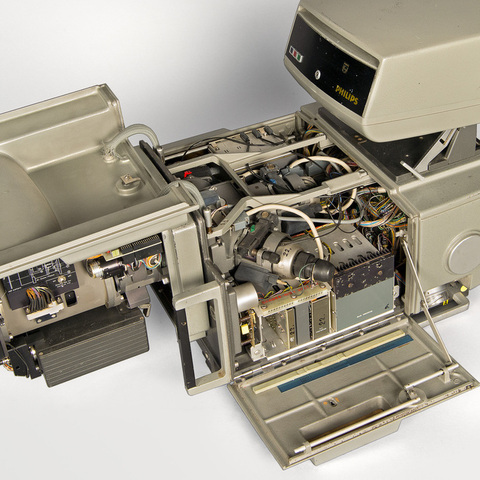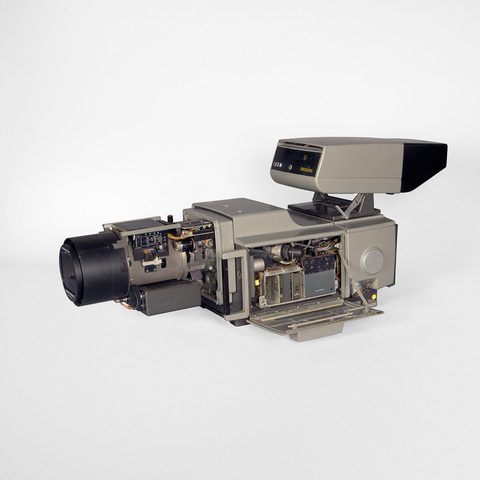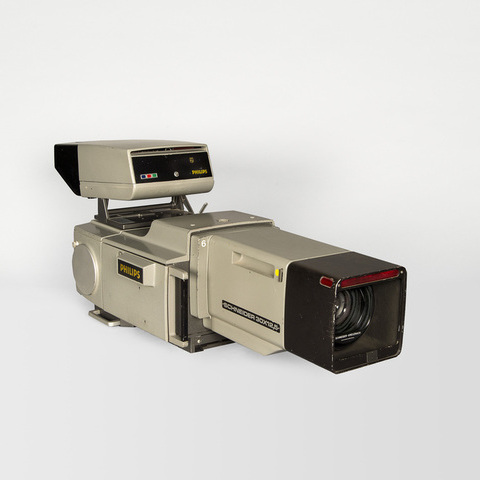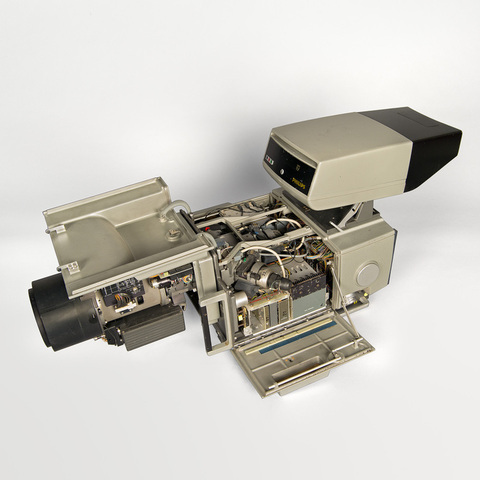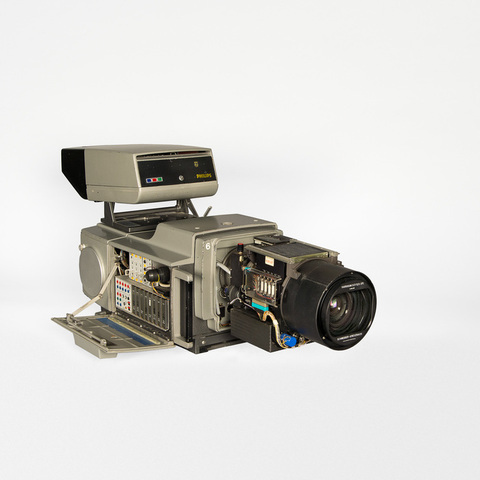Caméra de télévision couleurs
Fiche détaillée
Type de l'appareil
trois tubes ; Plumbicon 1 inch ; séparateur à prismes horizontal ; roue à filtres ; système PAL 625 lignes, PAL 525 lignes, NTSC 525 lignes, SECAM 625 lignes ; viseur Philips 17 cm à tube ; zoom Schneider-Kreuznach 30 x 12,5 Variogon 1 : 1,7 / 12,5 - 375 motorisé
Auteurs
Informations non disponibles
Fabricants
Philips
Hollande, Eindhoven
Schneider-Kreuznach
Bad Kreuznach
Utilisateurs
Informations non disponibles
Distributeurs
Philips
Paris
Sujet du modèle
Informations non disponibles
Objectif
Schneider-Kreuznach 30 x 12,5 Variogon 1 : 1,7 / 12,5 - 375, n° 13 003 285
Taille de l'objet
Ouvert :
Informations non disponibles
Fermé :
Longueur : 122 cm
Largeur : 44 cm
Hauteur : 50 cm
Diamètre :
Informations non disponibles
Taille de la boîte de transport
Informations non disponibles
Remarques
Marques : "Philips" ; "Certification : this product complies with applicable DH EW Standards under the radiation control for health and safety Act of 1968 (of USA). Manufactured by N. V. Philips Breda - Netherlands. Date June 1975".
"Cette caméra, équipée d'un zoom Schneider 15 X pour studio, est magnifique, d'une qualité de construction comparable aux TTV 1515 Thomson, mais elle est en réalité beaucoup plus moderne. Il lui manquait cependant la liaison Triax qui a fait le succès de Thomson. Cette caméra est large et plate car le séparateur à prismes est horizontal contrairement à toutes les caméras qui ont suivi où il est toujours placé dans le plan vertical" (Bernard Tichit).
"LDK 5. Operational flexibility. All video processing in camera ; coded output, less vulnerable to interferences. Sync-locking to studio timing reference ; colour black or CVBS. Different cable and RF modes of operation. Outstanding stability by monolithic design of optical and coil system, automatic positioning, and high gain-high feedback operational video amplifiers. 1-inch Plumbicons tubes ; Anti-Comet Tail ; minimum lag. Sturdy, magnesium-alloy cast camera housing. Rotatable and tiltable viewfinder. Wide range of zoom lenses available. Small base station in self-contained sections with simple interconnections. Digital control system ; low data rate (2400 Bd). Clue facility. This new studio colour camera chain for both indoor and outdoor use fulfils the requirements of modern television broadcasting. It is a modular design consisting of a low-profile camera and a small base station. [...] Camera and viewfinder are built into light-weight magnesium-alloy cast housings. Zoom lenses with servo-controlled iris and manually controlled focus and zoom, as well as with full servo control, are available. [...] A key aspect of the mechanical design of the camera is the horizontal spider layout of the pick-up section. This section, which comprises the colour beamsplitting prism and the deflection units with camera tubes, is incorporated in one machined, magnesium cast block. This block is screwed to the camera front, to which the lens is also clamped. In this way, the whole optical part of the camera forms one rigid structure ensuring maximum alignment precision and registration stability. The camera employs the new 1-inch Plumbicon tubes, type XQ 1080, in conjuntion with deflection units of utmost mechanical and electrical precision. These tubes of separate-mesh contruction are fitted with a ceramic centring ring, which reduces the tolerances in optical aligment and improves the fixing of the tube target with respect to the optical image. An anti-comet tail (ACT) gun design ensures better highlight handling. An internal bias light conductor gives a uniform bias lighting of the tube target, and the resultant, artificial dark current reduces beam discharge lag. The Plumbicon tube is inserted into its deflection unit from the rear, so that the latter need not be removed from the camera for tube exchange. The deflection coil assembly has a mu-metal shielding in one piece, for optimum screening against external magnetic fields. In addition to the complete electronic circuitry for sync generation and scanning, video processing and encoding, and Plumbicon supply, the camera contains the necessary circuits for processing the control date from the base station and for modulating and frequency multiplexing" (Philips Colour Camera Type LDK 5, Philips, s.d.).
Bibliographie
Philips Colour Camera Type LDK 5, Philips, s.d.
